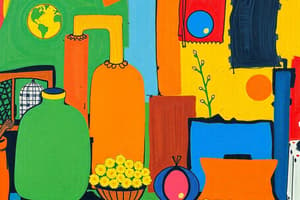Podcast
Questions and Answers
What is a tangible product?
What is a tangible product?
- An insurance policy
- A physical object that can be perceived by touch (correct)
- A want or need that is satisfied by a product
- A service that can be offered to a market
What is an example of a tangible product?
What is an example of a tangible product?
- A publicity campaign
- A soccer ball (correct)
- An insurance policy
- A consumer promotion
What is an intangible product?
What is an intangible product?
- A physical object that can be perceived by touch
- A want or need that is satisfied by a product
- A product that can only be perceived indirectly (correct)
- A service that can be offered to a market
What is an example of an intangible product?
What is an example of an intangible product?
What is a product in marketing?
What is a product in marketing?
What is the primary characteristic of a physical product?
What is the primary characteristic of a physical product?
What type of product is a JPG file?
What type of product is a JPG file?
Which of the following is an example of a service?
Which of the following is an example of a service?
What is the main difference between a conference and a convention?
What is the main difference between a conference and a convention?
What is an 'add-on' service in the context of tourism and hospitality?
What is an 'add-on' service in the context of tourism and hospitality?
What is the primary purpose of a product or service?
What is the primary purpose of a product or service?
What type of product is a yoga class or a therapy session?
What type of product is a yoga class or a therapy session?
What is an example of a tangible product?
What is an example of a tangible product?
What is the purpose of pricing a product?
What is the purpose of pricing a product?
What is an example of an event planning product or service?
What is an example of an event planning product or service?
Flashcards are hidden until you start studying
Study Notes
Classification of Products
- Intangible data products can be further classified into virtual digital goods (VDG) and services or ideas.
- Goods are physical products capable of being delivered to a purchaser, involving the transfer of ownership from seller to customer.
- Services are non-material actions resulting in a measurable change of state for the purchaser, caused by the provider.
Types of Products in Tourism and Hospitality
- Tours and Transport: allowing tourists to get to their destinations and get around.
- Conferences and Conventions: opportunities for people to network and learn, with conferences focusing on knowledge exchange and professional development, and conventions celebrating shared interests.
- Entertainment: infrastructure in tourism providing facilities and services designed to provide entertainment experiences for tourists.
- Restaurant facilities: physical amenities and services provided by a restaurant to enhance the dining experience.
- Food and Beverage services: professional industry providing meals to customers for various purposes.
- 'Add-on' services: additional products or services that customers can purchase to enhance their primary booking.
Steps in Promoting a Product
- Accurately provide information about products and services to customers through brochures, websites, etc.
- Employ selling techniques to encourage usage and purchase, such as social selling.
- Above the line promotions include advertising, press releases, consumer promotions, etc.
- Below the line promotions include trade discounts, freebies, incentive trips, awards, etc.
- Personal selling: one of the most effective ways of customer relationship, best for high-value or premium products.
- Sales promotions: include freebies, contests, discounts, free services, passes, tickets, etc.
- Public relations: deliberate, planned, and sustained effort to establish and maintain mutual understanding between the company and the public.
What are Products?
- A product is defined as a "thing produced by labor or effort" or the "result of an act or a process."
- In marketing, a product is anything that can be offered to a market that might satisfy a want or need.
- Products can be classified as tangible or intangible.
- Tangible products are physical objects that can be perceived by touch, such as a building, vehicle, or gadget.
- Intangible products are products that can only be perceived indirectly, such as an insurance policy.
The Four Ps of Marketing
- The four Ps of marketing are: product, price, place, and promotion.
- Product: what your company sells, such as smoothies or jewelry.
- Price: the amount of money you charge customers for the product or service.
- Place: where the product or service is sold, such as a physical store or online platform.
- Promotion: the methods used to communicate with customers and promote the product or service.
Event Planning Products and Services
- Event management, event coordination, theming, decorating, and styling.
- Catering, entertainment, and venue sourcing.
Pricing a Product
- The price of a product or service is affected by factors such as supply costs, seasonal discounts, and competitors' prices.
- The price must be related to the product's real and perceived value.
- Effective pricing strategies involve understanding costs, adding up variable costs, and considering other factors that affect pricing.
Studying That Suits You
Use AI to generate personalized quizzes and flashcards to suit your learning preferences.




